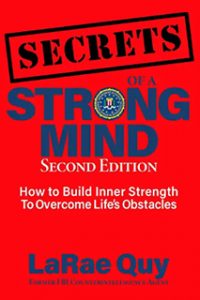The things that come closest to killing us are the things that make us grow. Damn, why do life’s best lessons need to come wrapped up in adversity? Our obstacles will not define us; we will be defined by how we overcame them. We’ve all experienced adversity in some form; sometimes we know why, but often we don’t. The problem is that many of us let adversity control our direction in life. This is when we need to rely on our resilience to move ahead.
The narrative we create around our adversity can either lead to personal growth or a growing sense of victimhood. It’s how we look at our roadblocks, setbacks, and trauma that will define how we evolve as a human being. Our brains need to make sense of the world around us, and this is most critical when faced with adversity. The pain and discomfort that comes with adversity have the surprising ability to clarify what is important in our life. If we experience an intense loss, the important things in life spring into focus at lightning speed.
Many of the mindsets that are essential for a strong mind, like positive thinking, self-compassion, and gratitude, can be developed when things are going good. We shouldn’t squander the opportunity to use the good times to develop these important mindsets so they’ll be in our toolbox when we need them.
Resilience, however, is one of those ugly beasts that needs adversity to develop.
It’s essential to get knocked down so we can learn how to pick ourselves up and move ahead. One of the eternal facts of life is that setbacks, challenges, and obstacles are part of every endeavor. So, we have plenty of opportunities to make ourselves more resilient. We truly can learn as we go.
Psychologist Martin Seligman and other researchers were tasked by the U.S. Army to address the challenges faced by soldiers because of multiple deployments to Iraq and Afghanistan. The researchers were also asked to devise a preventive program to help enhance resilience, so they developed the Army’s Comprehensive Soldier Fitness (CSF) program. The CSF focused on three categories: emotional, social/family, and spiritual.
Years of research in behavioral studies led Seligman and his colleagues to conclude that a strong grounding in each of these categories would not only build resilience, they could quite possibly allow soldiers to experience post-traumatic growth.
War zones look different for all of us. For some, it’s the loss of a loved one, the failure of a marriage, or an unexpected pink slip. It’s up to you—you get to decide whether you’re a victim or a survivor.
The good news is that you don’t have to build your own toolbox if you want to grit up and come out of your trauma stronger than before. Here are practical tips from experts like Seligman and his colleagues:
1. Interpret Your Pain
It’s incredibly chic to be a victim these days. Even more fashionable among the trendy set is to be a victim without a spine; someone who retreats to a safe place because they’re too delicate to hear a point of view that differs from their own.
Victims avoid their pain and blame others. Survivors embrace their pain and look for ways to learn from it. The story you choose to explain yourself when faced with adversity will determine your future—a poor me victim explanation will only lead to more pain while a strong survivor example will only lead to better problems because you know you’ll learn from them.
In other words, once you decide on your mindset, you also get to choose which emotions will become dominant. A positive mindset allows you to broaden your perspective so you can reappraise your situation while a negative one only narrows your options. Positive thinking allows you to reframe your hardship as a challenge so you can find opportunities in adversity.
To build resilience among U.S. soldiers, the CSF brought in elements of positive psychology and discovered that gratitude is an essential component of positive thinking. Because here is the thing: it is impossible to be grateful and negative at the same time. Gratitude is a powerful tool to keep handy—it is one of the most powerful emotions in the world because it allows you to love not only yourself but others as well.
How To Make It Work For You: Problems will never go away so maintain a positive attitude and strive to see the silver lining of your situation. Everything you believe about yourself and the world will be challenged at some point in time. Each one of these challenges will also present excellent opportunities for you to grow as a human being.
2. Invest in Relationships
People need other people to thrive. We all benefit when someone cares about us and our welfare. Since we’re stuck with family, it’s important to pick our friends with care. If we’re honest with ourselves, most of us take our relationship with others for granted, especially during the good times.
People who have a low opinion of their own worth and feel unloved tend to choose friends who confirm it. Maybe they don’t think they deserve any better. Or maybe they’re too lazy to look for something better. Even worse, if they surround themselves with loser friends, they start to look like the winner of the bunch.
It’s time to define loser friends. They are people who:
- Are not supportive of you.
- Not there when you need them.
- Tend to be negative about everything.
- Agree with everything you say.
- Only show up when they need you.
- Have no desire to make their life better.
- Expect you to drop everything when they have a crisis.
- Tend to think everything that relates to them is a crisis.
- Have a negative impact on your mental health.
We are influenced by the people with whom we spend the most time. They create an environment that influences the way we think, our self-esteem, and our decisions. We will interact with many people over the course of our life, but the few who are closest to us have the greatest impact on our way of thinking and our decisions.
“People are like dirt. They can either nourish you and help you grow as a person or they can stunt your growth and make you wilt and die.” — Plato
Strong and healthy relationships help us build strength and protect us in times of stress and adversity, but there are other benefits as well. The Grant Study followed a group of men for their entire lives and found that the capacity to love and be loved was the single strength most clearly associated with well-being at age eighty.
According to the study, there was only one characteristic that distinguished the happiest and most content ten percent from everyone else—the strength of their relationships. Social support was a far greater predictor of happiness than any other factor. That included GPA, family income, SAT scores, age, gender, or race.
The Journal of Consumer Research recently published a study that summarizes the difference between amateurs and experts. Amateurs focus on positive feedback and want to hear what they’re doing right so they can continue on the same path.
Experts do not care about what they’ve done right. Instead, they’re more interested in how they can make progress and they rely on the right relationships to make it happen. They don’t surround themselves with sycophants and other bootlickers who are too afraid to speak the truth.
How To Make It Work For You: Surround yourself with friends and/or family members who will give you honest feedback. No one needs negative feedback, but you need constructive tips on how to tweak your performance to take it to the next level.
3. Draw On Faith
The third component of the CSF is spiritual and it encourages people to explore what builds the human spirit. The spiritual dimension is defined as identifying one’s purpose, core values, beliefs, and life vision. These are the elements that enable one to build inner strength, make meaning of experiences, behave ethically, persevere through challenges, and be resilient when faced with adversity.
There’s a distinction between religion and spirituality: we can change our religion while at the same time retain our spirituality. Religion is a specific path to God or a higher being, while spirituality is the direct experience of God or a higher being.
Of course, we’ve all met that person who wants to be their own God. That usually works just fine while everything goes their way, but the well goes dry when they’re hit with death, trauma, or adversity and they have only themselves to believe in. They lack belief in a power that is bigger, better, and more powerful than themselves.
People who have a deep spiritual connection rarely fear death. They may fear a particular way of dying that involves suffering, but death itself doesn’t scare them because they have faith that there’s something, and someone, else out there.
For many who have suffered trauma, spirituality provides the bridge between victimhood and returning to the world. A variety of spiritual practices can help people connect with God or find their place in the universe.
Scientists have found that the brains of people who spend time in prayer and meditation are different. Neuroplasticity allows us to rewire and change our brains with experience and training. The more we focus on something, whether it’s math or God, the more it becomes written into the neural connections of our brain.
Prayer produces an opportunity for people to explore what is truly important to them and how it might work in their life. Research by Seeman, Dubin, and Seeman found that meditation also enhanced a biomarker of a substance in the brain that would lead a Special Forces member to have an increased level of physiological and psychological resilience.
The world is a scary and stressful place that values perfectionism, materialism, and selfishness over human connection. Any type of spiritual belief and practice is a way to bring hope back into our lives. Without hope, there is neither peace nor love.
How To Make It Work For You: Religion and spirituality are deeply personal issues and unique to every person but the key is to bring awareness into your life. Start slowly so you don’t lose enthusiasm, take regular retreats so you can explore and reflect on spiritual matters in-depth, and practice the spiritual takeaways as they come into your awareness.
© 2020 LaRae Quy. All rights reserved.
You can follow me on Twitter, Facebook, Instagram, AND LinkedIn
Are you mentally tough? Here is my FREE Mental Toughness Assessment
Check out my new online training program at www.SecretsOfAStrongMind.com
Get my new book, “Secrets of a Strong Mind (second edition): How To Build Inner Strength To Overcome Life’s Obstacles”
Author of “Mental Toughness for Women Leaders: 52 Tips To Recognize and Utilize Your Greatest Strengths”





Terrific post LaRae! Being resilient for me has come down to looking at my challenges through a different lens. When I am working with an individual who only sees negative pieces I try to problem solve about possibilities. Dwelling on mistakes will only add to our frustrations. Asking how I can do things differently the next time is so empowering.